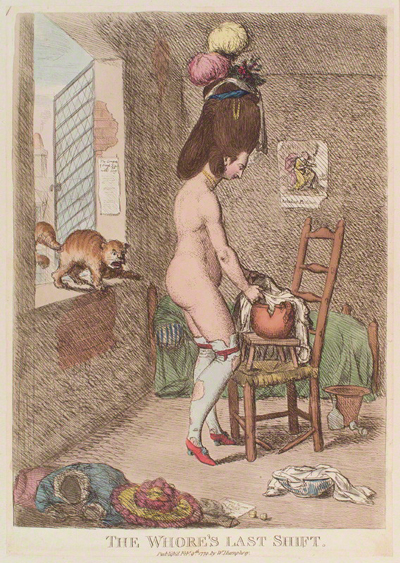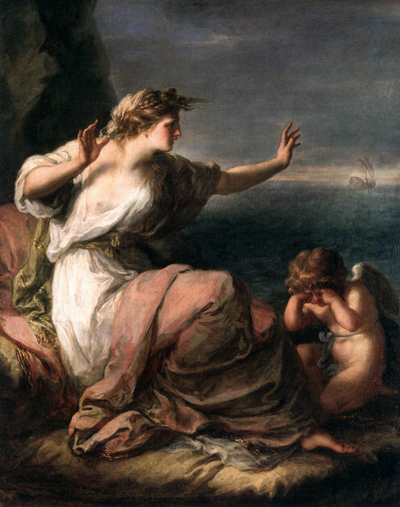The Whore's Last Shift
This is one of several early prints by Gillray that prominently feature women who are (or may be) prostitutes. They include A Trip to Cox's Heath which has sometimes been attributed to John Hamilton Mortimer, Squire Thomas Just Arrived, and Female Curiosity. All of them were published by William Humphrey who was a good deal older and more experienced than Gillray (39 to Gillray's 22) in 1779 and who may have been responsible for selecting the topics.

© National Portrait Gallery, London
Like many caricatures, The Whore's Last Shift is based upon a pun, playing upon at least two meanings of "shift": the whore's last device or stratagem (to make ends meet),and the whore's last undergarment.
The woman has presumably returned to her room after a night out in her more colorful and attractive clothes (now heaped on the floor in the foreground). She is still wearing her shoes and the high, ornamental, head dress fashionable in the 1770's. But without her dress, and with the light provided by the open window, we can see the numerous holes in her stockings as she washes her undergarments in a cracked chamber pot on a broken chair. The room is pathetically small, the bed's covering is tattered, and the two boxes of "Leakes Famous Pills" in the foreground suggest that she has a venereal disease.
Though the woman is almost totally nude, there is no attempt at titillation here as there is in the two later Gillray prints about Lady Worsley. Combined with all the other details— the empty wine bottle, the single glass, the heavily ironic, broadside ballad "The comforts of Single Life—all suggest a lonely, joyless, and precarious existence. Even the cat on the window sill seems threatening. But there is perhaps a certain pathetic dignity in the fact that in spite of everything, she is engaged in an act of cleaning.
Something of the woman's history may be suggested by the print on the back wall labelled "Ariadne Forsaken." In that story, Ariadne, the daughter of King Minos falls in love with Theseus and provides him with the sword and thread that enables him to defeat the Minotaur and escape from the labyrinth. She mistakenly elopes with him but he abandons her, sailing away one night while she is sleeping, leaving her to fend for herself on Naxos.

Ariadne Abandoned by Theseus [Before 1782]
Gemaeldegalerie Alte Meister - Staatliche Kunstsammlungen Dresden
The story had been recently retold in a translation from the Latin poet Catullus called (appropriately) Ariadne Forsaken in 1772, and had been the subject of at least two paintings by Angelica Kauffmann that Gillray may have seen. From that perspective, the "whore" in Gillray's print may have been one of countless young women who were literally betrayed by a former lover into her present desperate condition.
Sources and Reading
- Commentary from the British Museum on The Whore's Last Shift Vic Gatrall, City of Laughter, 2006, pp. 104-106.
- "Ariadne," Wikipedia
- Ariadne Forsaken, A Poem [Translated from Catullus. 1772
Comments & Corrections
NOTE: Comments and/or corrections are always appreciated. To make that easier, I have included a form below that you can use. I promise never to share any of the info provided without your express permission.